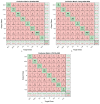AI Techniques of Dermoscopy Image Analysis for the Early Detection of Skin Lesions Based on Combined CNN Features
- PMID: 37046532
- PMCID: PMC10093624
- DOI: 10.3390/diagnostics13071314
AI Techniques of Dermoscopy Image Analysis for the Early Detection of Skin Lesions Based on Combined CNN Features
Abstract
Melanoma is one of the deadliest types of skin cancer that leads to death if not diagnosed early. Many skin lesions are similar in the early stages, which causes an inaccurate diagnosis. Accurate diagnosis of the types of skin lesions helps dermatologists save patients' lives. In this paper, we propose hybrid systems based on the advantages of fused CNN models. CNN models receive dermoscopy images of the ISIC 2019 dataset after segmenting the area of lesions and isolating them from healthy skin through the Geometric Active Contour (GAC) algorithm. Artificial neural network (ANN) and Random Forest (Rf) receive fused CNN features and classify them with high accuracy. The first methodology involved analyzing the area of skin lesions and diagnosing their type early using the hybrid models CNN-ANN and CNN-RF. CNN models (AlexNet, GoogLeNet and VGG16) receive lesions area only and produce high depth feature maps. Thus, the deep feature maps were reduced by the PCA and then classified by ANN and RF networks. The second methodology involved analyzing the area of skin lesions and diagnosing their type early using the hybrid CNN-ANN and CNN-RF models based on the features of the fused CNN models. It is worth noting that the features of the CNN models were serially integrated after reducing their high dimensions by Principal Component Analysis (PCA). Hybrid models based on fused CNN features achieved promising results for diagnosing dermatoscopic images of the ISIC 2019 data set and distinguishing skin cancer from other skin lesions. The AlexNet-GoogLeNet-VGG16-ANN hybrid model achieved an AUC of 94.41%, sensitivity of 88.90%, accuracy of 96.10%, precision of 88.69%, and specificity of 99.44%.
Keywords: ANN; PCA; RF; deep learning; fusion features; skin lesion.
Conflict of interest statement
The authors declare no conflict of interest.
Figures

















References
-
- Ragaa T.M., Sahar S.A. Skin Managements and Diseases: A Systematic Article Review. Med. J. Cairo Univ. 2022;90:1773–1780. doi: 10.21608/mjcu.2022.272629. - DOI
-
- Melanoma Survival Rates|Melanoma Survival Statistics. [(accessed on 22 January 2023)]. Available online: https://www.cancer.org/cancer/melanoma-skin-cancer/detection-diagnosis-s....
Grants and funding
LinkOut - more resources
Full Text Sources

